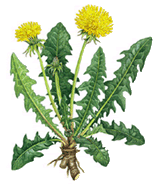 The dandelion is a perennial, herbaceous plant with long, lance-shaped leaves. They're so deeply toothed, they gave the plant its name in Old French: Dent-de-lion means lion's tooth in Old French.
The dandelion is a perennial, herbaceous plant with long, lance-shaped leaves. They're so deeply toothed, they gave the plant its name in Old French: Dent-de-lion means lion's tooth in Old French.The leaves are 3 to 12" long, and 1/2 to 2-1/2" wide, always growing in a basal rosette.
he flower head can change into the familiar, white, globular seed head overnight. Each seed has a tiny parachute, to spread far and wide in the wind.

The thick, brittle, beige, branching taproot grows up to 10" long. All parts of this plant exude a white milky sap when broken.
Dandelion leaves are at their best when they've just emerged.
There are no poisonous look-alikes. Other very similar Taraxacum species, as well as chicory and wild lettuce only resemble dandelions in the early spring. All these edibles also exude a white milky sap when injured, but chicory and wild lettuce leaves have some hair, at least on the underside of the midrib, while Taraxacum leaves are bald. Unlike the other genera, Taraxacum stays in a basal rosette. It never grows a tall, central, stalk bearing flowers and leaves.
Dandelions are especially well-adapted to a modern world of "disturbed habitats," such as lawns and sunny, open places. They were even introduced into the Midwest from Europe to provide food for the imported honeybees in early spring. They now grow virtually worldwide. Dandelions spread further, are more difficult to exterminate, and grow under more under adverse circumstances than most competitors.
Most gardeners detest them, but the more you try to weed them up, the faster they grow.
The taproot is deep, twisted, and brittle.
Unless you remove it completely, it will regenerate. If you break off more pieces than you unearth, the dandelion wins. "What's a dandelion digger for?" a dandelion asked.
"Itís a human invention to help us reproduce," another dandelion replied.
Collect dandelion leaves in early spring, when they're the tastiest, before the flowers appear. Harvest again in late fall. After a frost, their protective bitterness disappears. Dandelions growing in rich, moist soil, with the broadest leaves and largest roots, are the best. Select the youngest individuals, and avoid all plants with flowers. Some people eat the greens from spring to fall, when they're very bitter. Others boil out the summer bitterness (and water-soluble vitamins) out in two changes of water. Itís all a matter of preference.
Dandelion greens are wonderful in salads, sautÈed or steamed. They taste like chicory and endive, with an intense heartiness overlying a bitter tinge.
People today shun bitter flavorsótheyíre so conditioned by overly sweet or salty processed food. But in earlier times, we distinguished between good and bad bitterness.Mixed with other flavors, as in a salad, dandelions improve the flavor.

I also love sautÈing them for about 20 minutes with onions and garlic in olive oil, adding a little home-made wine before they're done. If you're not used to the slight bitterness, cook them with sweet vegetables, especially sliced carrots and parsnips. Boiling dandelions in one or more changes of water makes them milderóa good introduction if you're new to natural foods. Early spring is also the time for the crownógreat sautÈed, pickled, or in cooked vegetable dishes.
You can also eat dandelion flowers, or use them to make wine. Collect them in a sunny meadow, just before mid-spring, when the most flowers bloom. Some continue to flower right into the fall. Use only the flowerís yellow parts. The green sepals at the flowerís base are bitter.
The flowers add color, texture, and an unusual bittersweet flavor to salads. You can also sautÈ them, dip them in batter and fry them into fritters, or steam them with other vegetables. They have a meaty texture that contrasts with other lighter vegetables in a stir-fry dish or a casserole. A Japanese friend makes exceptionally delicious traditional dandelion flower pickles, using vinegar and spices.
The taproot is edible all year, but is best from late fall to early spring. Use it as a cooked vegetable, especially in soups. Although not as tasty as many other wild root vegetables, Itís not bad. I remember finding large dandelions with huge roots growing on the bottom of a grassy hillside. They were only mildy bitter, so I threw them into a potato stock. With the added scallions, tofu, ginger, carrots and miso, this became an excellent Japanese miso soup.
Pre-boiling and changing the water, or long, slow simmering mellows this root. Sweet vegetables best complement dandelion roots. Sauteing the roots in olive oil also improves them, creating a robust flavor. A little Tamari soy sauce and onions complete this unusual vegetable side dish.
The leaves are more nutritious than anything you can buy. They're higher in beta-carotene than carrots. The iron and calcium content is phenomenal, greater than spinach. You also get vitamins B-1, B-2, B-5, B-6, B-12, C, E, P, and D, biotin, inositol, potassium, phosphorus, magnesium, and zinc by using a tasty, free vegetable that grows on virtually every lawn. The root contains the sugar inulin, plus many medicinal substances.
Dandelion root is one of the safest and most popular herbal remedies. The specific name, officinale, means that It's used medicinally. The decoction is a traditional tonic. Itís supposed to strengthen the entire body, especially the liver and gallbladder, where it promotes the flow of bile, reduces inflammation of the bile duct, and helps get rid of gall stones. This is due to its taraxacin. Itís good for chronic hepatitis, it reduces liver swelling and jaundice, and it helps indigestion caused by insufficient bile. Don't use it with irritable stomach or bowel, or if you have an acute inflammation.
The modern French name for this plant is pissenlit (lit means bed) because the root and leaf tea act on the kidneys as a gentle diuretic, improving the way they cleanse the blood and recycle nutrients. Unlike pharmaceuticals diuretics, this doesn't leach potassium, a vital mineral, from the body. Improved general health and clear skin result from improved kidney function. One man I spoke to even claims he avoided surgery for urinary stones by using dandelion root tea alone.
Dandelions are also good for the bladder, spleen, pancreas, stomach and intestines. Itís recommended for stressed-out, internally sluggish, and sedentary people. Anyone who's a victim of excessive fat, white flour, and concentrated sweeteners could benefit from a daily cup of dandelion tea.
Dandelion rootís inulin is a sugar that doesn't elicit the rapid production of insulin, as refined sugars do. It helps mature-onset diabetes, and I used it as part of a holistic regime for hypoglycemia (low blood sugar).

Dandelion leaf infusion also good at dinner time. Its bitter elements encourage the production of proper levels of hydrochloric acid and digestive enzymes. All the digestive glands and organs respond to this herbís stimulation. Even after the plant gets bitter, a strong infusion, is rich in vitamins and minerals, and helps people who are run-down. Even at its most bitter (Taraxacum come from Arabic and Persian, meaning "bitter herb"), it never becomes intolerably so, like golden seal and gentian.
The leafís white, milky sap removes warts, moles, pimples, calluses, and sores, and soothes bee stings and blisters.
Unlike most other seeds, dandelionsí can germinate without long periods of dormancy. To further increase reproductive efficiency, the plant has given up sex: The seeds can develop without cross-fertilization, so a flower can fertilize itself. This lets it foil the gardener by dispersing seeds as early as the day after the flower opens.
One of my Springtime Favorites!! :)
ReplyDelete(((Big Hugs to YOU!)))
Cửa lưới chống muỗi
ReplyDeleteTìm hiểu cấu tạo cửa lưới chống muỗi sợi thuỷ tinh
Những ưu điểm của màn hình Dell cũ mà bạn không ngờ tới
ReplyDeleteHướng dẫn chọn linh kiện máy tính cũ
Mua cây máy tính cũ giá rẻ tại Hà Nội